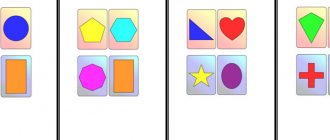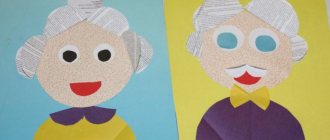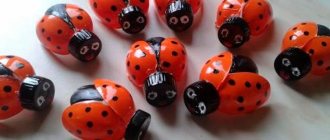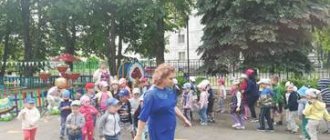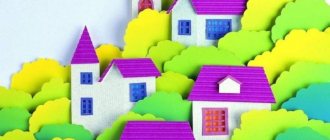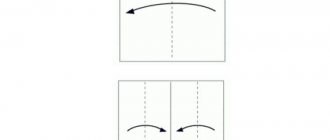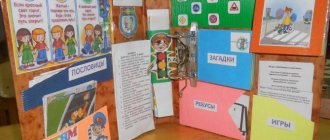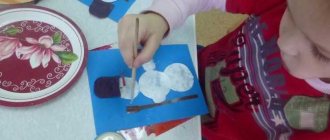Geometric applique
This article is intended for practicing appliqué with children.
Geometric applique will unobtrusively introduce the baby to the basic properties of objects: size, color, shape. The drawing is made up of simple geometric shapes. The application is associated with cognitive activity and has a huge impact on the development of the child’s creative and mental abilities. It will be of great benefit and will help develop work skills. When starting to introduce a child to an application, you need to remember three main rules: 1) the child cannot hold his attention for a long time 2) he should be interested 3) the child needs praise for the work done. Before starting class, cut out geometric shapes of different colors and sizes. Pay the baby's attention to the figure, its color and size. Help me put the shapes in the right order.
Flower applique.
If the child is still very small, then it is better to perform the application together. Place the flower on paper and ask your child to repeat after you. Show how to use glue and glue a picture. At first, use 2-3 geometric shapes in the application; for better memorization, pronounce the names and comment on your actions.
The flower is made of circles and squares. The circles are the petals of the flower, and the squares laid out in the shape of a diamond are the stem of the flower.
The caterpillar is made entirely of circles and only a small triangle is required for the mouth.
The butterfly applique will be more complex, it includes new geometric shapes. The number and size of parts increases.
It’s worth trying to make a general picture of geometric shapes with your child. First, work on each element of the future picture separately (flower, butterfly, caterpillar), and then assemble the overall picture. While doing appliqué with your child, ask him who he is portraying? Who are caterpillars and what do they turn into? By conducting classes using this method, the child’s horizons develop. If it’s winter outside, then you should try to make a simple winter geometric applique. First, we try to lay out the house from the figures, and then glue it onto the base for the applique.
We assemble the Christmas tree from green triangles, and from small circles we make beads for the Christmas tree. Everything is also simple with the snowman, it consists of circles of different sizes, one trapezoid and two different small triangles.
Application of geometric shapes “Cats and mice”.
Geometric paper applique. Garland.
Our task is to teach the child to stick exactly geometric shapes: circles and ovals, rhombuses and triangles, squares and rectangles, alternating them by color and shape. Show your child how to make a paper applique, imitating a garland on a string using circles and flags.
Ship made of geometric shapes.
The geometric application should be interesting, not very complex and not very simple, only then can the child be interested in the work. Cut out various geometric shapes from colored paper and construct different ships from them. It can be one large ship or several small ones, with sails or a funnel. Glue the result you like onto paper.
Source: https://detskiepodelki.com/podelki-iz-bumagi/12-geometricheskaya-applikaciya.html
Aquarium
This craft involves cutting and gluing a large number of shapes.
Materials needed to make the craft:
- Colored paper or cardboard.
- Markers or gouache.
- Scissors.
- Glue.
- Brush for applying glue.
Instructions:
On white paper you need to draw an aquarium using felt-tip pens or paint. We draw algae, pebbles, bubbles and markings for our future fish.
- Making a diaper cake with your own hands: a step-by-step master class on how to fold a gift for newborns (100 photos)
- DIY crafts from egg trays: original toy ideas for children and useful crafts for adults (115 photos)
- How does an air source heat pump work?
We cut out triangles of two sizes from colored paper. The large elements are the body of the fish, the small ones are the tails. To make the baby’s work easier, you can draw eyes and tails on the triangles.
Next, we invite the child to place the fish in the aquarium.
Applications made from paper figures are a fascinating activity not only for children, but also for their parents. Invent, fantasize and create simple and complex compositions together with your baby. Nothing brings children and parents closer together than joint creativity.
In this article we talked about geometric applications, their age appropriateness, and conducted small master classes. Now you know how to make a geometric applique for a child and with him.
Application templates from geometric shapes for children
Don't know what to do with your child? Great fun is creating appliqués from geometric shapes. This activity does not require special materials or preparation; it develops fine motor skills, imagination and thinking of the child, and is even very exciting for an adult. Appliqué is also often practiced in kindergarten, along with drawing, putting together puzzles, singing, etc. What types of applications are there?
Types of applications
People are accustomed to the fact that appliqué is a childhood hobby, but the beautiful mosaics and stained glass windows on the windows and walls of the most beautiful buildings in the world are also, to some extent, appliqué.
What is its essence? This is a set of individual parts assembled into a single whole (these can be either arbitrary geometric shapes or parts that have a predetermined shape and place in the finished drawing).
Applications can be made from different materials:
- From paper.
- From cardboard.
- From fabric.
- From cereals and seeds.
- From plant leaves.
- From threads.
- From rhinestones.
- From any other materials that can be attached to any base, thereby creating a pattern.
But still, paper remains the most inexpensive, simple and safe for a child, and therefore the most common material for creating appliqués. And the range of possible ideas for working with it is limitless. For example, using the appliqué technique from geometric shapes for children, you can make:
- Flowers and other plants.
- Animals.
- Cars, ships, planes, etc.
- Houses and architectural buildings.
- Little people and different clothes for them.
- Clowns, artists, magicians.
- Fairy tale characters.
- Collage in the form of a colorful rug.
- Entire story compositions.
Application "Owl" made of leaves and colored paper
For the little ones
At the age of 4–5 years, a child, of course, cannot independently come up with a composition, select details for it, cut them out and arrange them correctly on paper. Therefore, special coloring books with applications for kids were invented.
They already give the details. They just need to be cut out. All the details are very simple and are already painted. The contours of the finished drawing, and sometimes the background to it, are also given.
The parts just need to be laid out in the correct way, like puzzles, and carefully glued. Even a small child can easily cope with this task. True, you shouldn’t leave him alone with scissors .
Therefore, either cut out the parts yourself, or watch how he does it.
For example, you can make a funny hare or squirrel from circles and semicircles. And the cunning fox is made of triangles. These crafts from geometric shapes for children are very simple, the number of parts is only 5 or 6 pieces.
Applications for first graders
At the age of 6-8 years, the child’s skills are already more developed. Therefore, crafts made from geometric shapes for the 1st grade of school or the senior group of kindergarten have smaller and more complex details. In addition, a first-grader can already independently compose a separate object or even a small composition from them.
For example, a New Year tree made up of green triangles of different sizes (decreasing towards the top) and multi-colored bright circles representing balls. Such balls can be made voluminous by using rhinestones, beads, buttons or other similar details instead of paper.
You can develop the New Year theme and make Father Frost and the Snow Maiden, a snowman or some other characters associated with this holiday. Or create some other fairy tale plot.
What is an application and its benefits for schoolchildren
There are applique lessons on all sorts of topics. You can create works from various types of materials - paper, fabric, natural components. In your work you can use: sunflower seeds, pumpkin seeds, buckwheat, semolina, dried leaves or branches.
Creative compositions are possible on all sorts of topics - vegetables, fruits, animals, people, etc. Teachers can prepare interesting topics for applications that are of interest to schoolchildren. This creative activity is aimed at the broad capabilities of adolescents; it is able to develop the horizons of school-age children, find their talents and determine their abilities.
Applique classes in primary school are a fascinating type of learning for schoolchildren. During these lessons, schoolchildren learn about the world around them, develop their ability to use scissors and pencils, and improve them. The process of thinking about where it is better to stick this or that figure allows children to develop artistic taste and imaginative thinking.
The school lesson on application is multifaceted in the process of developing teenage thinking. Here children learn to recognize geometric shapes, distinguish colors, and natural phenomena. Classes instill accuracy and attentiveness in the student. The need to create this or that image forces the student to determine the characteristics of the object: what color it is, shape and size. To create their own small masterpieces, children need a flight of imagination and inspiration.
Application of geometric shapes for children: patterns, animals and other DIY crafts
Creating an applique from geometric shapes is very similar to working with a construction set, only here it is paper and flat. Instead of cutting out ready-made silhouettes of animals, plants and other objects from colored paper and pasting them in the required order, the child assembles them from simple geometric shapes according to the “what looks like” principle. This is much more interesting than it might seem!
The benefits of geometric applique for the development of preschool children
From early preschool age to 1st grade, exercises on connecting simple shapes into a single image are very useful for children. They help the little ones learn and remember what geometric shapes there are, and consolidate the names of colors.
Classes with this type of application also develop:
- fine motor skills;
- accuracy;
- eye gauge;
- perseverance and attentiveness;
- skills in working with scissors and glue;
- imagination, the ability to think outside the box (the triangle looks like the face of a fox or a piece of cheese);
- the ability to design, taking into account the order in which the figures will be placed on the finished craft - the parts that should be further away are glued first, and those that are closer to the viewer can be layered on top of the previous ones (for example, if the bear stands half-turned, first it is attached to the background one of his paws, then his body, and only then his second paw).
In addition, the process of selecting the necessary details and composing them embeds in the minds of little creators the understanding that much in the world around them consists of geometric shapes, and the complex is made up of the simple.
Organization of the process
Geometric applique does not require serious artistic skills from adults to organize the process of children's creativity. The main thing is to provide the kids with all the necessary materials and tools, to organize a safe and convenient space for work.
In order for children aged 2–4 years to successfully make an applique, they need to prepare a drawing with clear contours and cut out the appropriate number of parts. At the same time, they may need a personal example from a senior, showing on the same blank what, where and how to stick.
At this age, children can already arrange geometric shapes on a sheet of paper without ready-made contours, looking at a sample. You can have them cut out parts with straight lines, such as triangles, themselves from lined sheets of colored paper. In this case, you should make sure that the scissors are safe - with rounded ends.
- For older preschoolers.
At 6–7 years old, children are able to trace simple patterns and cut out appliqué details themselves. At this age, it is useful to provide them with an independent choice of the color scheme of the craft: for example, when depicting flowers, geometric patterns, butterflies. This helps them learn how to combine colors and develops their creativity.
To ensure that the work lasts, use high-quality, not too thin colored paper and make sure that the glue stick has not dried out.
Examples of geometric applications
To conduct a lesson, just search on the Internet and print ready-made templates. For older children, you can introduce a loose theme by giving a few basic shapes that they can use in their appliqué pictures.
Cat
Application designed for the middle group of kindergarten. To work on the cat you will need geometric shapes:
- a circle with a diameter of 3.5–4 cm for the head;
- one large right-angled triangle for the body and two small ones for the ears;
- a square with a side of 1.5 cm is a foot;
- an elongated oval for the tail (the wider the figure, the fluffier the tail will be).
The large triangle should be placed on the sheet so that the smaller leg is at the base, and the head with ears should be placed at the upper sharp corner. Place a paw on the side of the right angle of the body, and a tail on the lower end of the hypotenuse.
Car
The truck consists of almost the same number of parts as the previous craft. A small complication is that the window will need to be glued to the top of the cabin - this will immediately change its appearance and bring the whole composition to life in the eyes of the child.
Required figures:
- 2 rectangles for the cabin and body;
- 2 squares - hood and window;
- 2 round wheels;
- 1 large semicircle is the sand that the truck carries in the back.
After gluing up all the parts of the truck, kids will likely want to draw a picture of the person driving the car in the window.
House
A plot-based application that gives scope for creativity and additional elements. In order to make a house with a courtyard, you will need to prepare:
- 3 rectangles are the lower part of the house, the door and the pipe;
- 3 squares - for windows;
- 1 circle and 8 small triangles for the sun and its rays;
- a narrow long rectangle and a large oval - a tree in the yard;
- 1 small circle for the center of the flower, 9 ovals for the petals and a thin rectangular strip for the stem;
- oval for a puddle in the yard.
For children 3-5 years old
There are also applications intended for preschool children. They are quite simple. Children will learn a lot in the process. And most importantly, they will become familiar with geometric shapes and where they can be used.
Having printed templates, you need to make the application in the following sequence:
- Cut out templates from paper;
- Glue the parts to their corresponding places.
Next, you can color the drawing.
These applications are quite simple to make, so they are suitable for young children, so to speak, beginners in applications. You can choose from a wide range of designs and print the one that suits your child best.
The application is performed in the following order:
- Cut out the templates that are on the side of the page. Templates are obtained;
- Next, you need to use the prepared templates to cut out the parts from papers of the desired colors and stick them to their corresponding places.
Application of geometric shapes
Applique, which is easily made from geometric shapes, is one of the simplest, but also interesting activities for young children.
By doing this activity, your child will not only develop his creative potential and artistic taste, but also associative thinking, eye, and color perception. For preschoolers, such work will be the first step towards studying geometric shapes and their features.
Making appliqués from a wide variety of geometric shapes will also help develop a child’s understanding of color compatibility.
In kindergarten, especially in younger groups, children slowly begin to do such work. The teacher gives them ready-made parts, the children glue them on. The older the child gets, the more freedom he has when making this kind of applique: they independently cut out templates with scissors and create simple plot compositions.
At school, younger students continue to make appliqués during labor lessons. Often 1st grade students do work using this technique about wild animals, seasons, and make holiday-themed greeting cards for loved ones.
Grade 2 develops their imagination even more: they build entire cities and episodes from fairy tales out of paper on cardboard. The program is more complex for 4th grade students: their pictures are more realistic, rich in small details, and dynamic.
This application is perfect for kids. The picture shows the finished work and the parts that make up the machine. The parent or teacher must independently cut out the parts, help the child choose bright colors for his work, show how to properly apply glue to the parts with a brush, glue them onto cardboard, and remove excess glue with a napkin.
Figure “Fox”: master class with photos and step-by-step instructions
To work you will need:
- White sheet of office paper
- Orange colored paper
- Scissors
- Simple pencil
- Markers
- Oilcloths
- Tassels
- Glue
First, we make templates from orange paper. We cut out one large oval, which will be the body of our fox. Another smaller oval is the tail. The smallest ovals - paws - should be 4 pieces. One large isosceles triangle is the fox’s muzzle, two small ones are the ears.
When all the details are ready, we begin making the applique itself. In the middle of the white background sheet we glue the body of the animal. Gently apply glue to the part with a brush. In order not to stain the table, you can lay down oilcloth:
- We glue the muzzle to the body.
- Then the tail.
- We glue 4 paws so that the picture is dynamic, because the fox is in motion.
- We attach the remaining parts – the ears – to the sheet.
- After this, we need to draw on the fox’s mouth, nose and eyes, and also draw the background: grass, sun, trees, bushes - whatever comes to the child’s mind, he can draw on a white background. This is what the kids should get:
We make a bright applique “Rocket” with our own hands with a child
Required tools and materials:
- Black cardboard
- Colored paper
- PVA glue
- Plain or white pencil
- Scissors
- Glue brush
To make this work, we use ready-made templates, which are parts of our future rocket and starry cosmic sky:
On black cardboard we mark the border of the lower part of the ship with a pencil.
We twist the parts of our tail - the triangles - from the sharp end with scissors. This must be done carefully and carefully.
We glue the resulting twisted parts in three layers as follows.
We glue the remaining parts of the spaceship to the tail.
You need to finish the work by decorating the starry cosmic sky. Glue on yellow stars and a month.
Now our work is ready:
Making applications does not require much effort from the child and the parent or teacher, so the child can simply enjoy the process of creation, and the elder can observe and tell the child what and how to do so that his idea comes true.
The child’s finished works can be beautifully framed or made into a presentation in the form of a collage and hung in the children’s room.
This type of technology is very useful especially for kids, because it develops fine motor skills, learns how to independently make crafts, cards for mom, grandma, dad, brother or sister. Making crafts instills in a child diligence, hard work, and accuracy.
And an application made independently from geometric shapes introduces preschoolers to the basics of geometry for the first time, which makes it easier for parents in the future.
We invite you to watch several video master classes on the topic “Appliqué from geometric shapes.” Creative success!
Source: https://sdelala-sama.ru/podelki/821-applikaciya-iz-geometricheskih-figur.html
The simplest pictures
Children 1-2 years old are just getting acquainted with the world around them
It is important to teach them how to stick, excluding a clear composition. The lesson is conducted in the form of a game
Bear juggler
You should come up with a story about how the bear lost the juggling balls. The goal is to introduce children to the circle, consolidate knowledge about shades, and develop skills in handling adhesives. Required:
- mugs of different sizes and colored sheets;
- bear image, like a bright sticker;
- cardboard;
- glue containing starch or flour;
- dry and wet wipe.
When telling the story of how a cheerful little bear lost the balls, stick a character on it. Help your child find these balls, which differ in volume and tone. Now the little master himself has to lubricate the parts from the central part to the edge, arrange them around Toptygin and, using a dry cloth, press them to the base.
Fruit platter
This is a more complex craft that consolidates the knowledge gained. A plate or basket is drawn and cut out. Children deliver images of apples, pears, and grapes into it, matching them according to geometric configurations. After this, the names of tasty items and colors are repeated. Here you can try to make a caterpillar that doesn’t mind eating them.
Outline of lessons on applique, modeling (senior group)
- GBOU School No. 967
- Structural unit No. 3
- Topic: “Our farm” - applique of geometric shapes of different sizes
- Spent:
- Teacher gr. 2
Yumanova V.A.
- Moscow
- 2019
- Tasks:
- — Teach children to create images of different pets based on two ovals, adding various details.
- — Strengthen the ability to cut out ovals from rectangles folded in half, rounding the corners.
- — Teach children to convey spatial representations (near, side, right, left, closer, further).
Preliminary work. Looking at pictures of domestic animals and their babies. Designing images of animals from geometric mosaics. Reading fiction. Conversation on the content of the painting “The Farm”.
- Preparing the basis for a future composition: for children's work, the teacher cuts out green lawns and blue puddles (in the form of blots) from colored paper and prepares the basis for a collective composition - a large sheet of paper.
- Materials and equipment: paper rectangles (different in size and color), scissors, glue, glue brushes, glue sticks, cloth napkins, oilcloths, boxes for scraps, felt-tip pens for decorating small parts.
- Progress of the lesson
- The teacher shows the children the picture “Farm”.
- Educator: - Who lives on the farm?
- A finger game is played, depicting domestic animals.
- Dog
- The dog has a sharp nose
- There is a neck and a tail.
(Right palm on the edge, towards you. Thumb up. Index, middle and ring fingers together. The little finger alternately lowers and rises).
- horse
- The horse's mane curls,
- Playfully beats with its hooves.
(The right palm is on the edge away from you. The thumb is up. The left palm is placed on top of it at an angle, forming a mane with the fingers. The thumb is up. Two thumbs form the ears).
- Cat
- And the cat has ears
- Ears on the top of the head
- To hear better
- The mouse is in her hole.
(The middle and ring fingers rest against the thumb. The index and little fingers are raised up).
The teacher attaches ovals to the flannelgraph: three large ones and above them, at a short distance on the side, a slightly smaller one.
Educator: - Guys, who or what can these ovals be turned into? (Children's answers).
Educator: - And now I invite you to see how these ovals turn into different animals. Guys, look at the figures of three animals (dog, sheep, horse), which are based on ovals - a large one (torso) and a small one (head).
- Educator: - I will show you pictures, and you must say who it is and how you guessed about it.
- All these animals are similar in that they have a large oval body and a small oval head; But animals differ in other parts of the body - tails, necks, legs.
- Educator: - I will leave the pictures on the board so that while you work you can compare your ideas about animals with them.
- Educator: - Children, tell me how to cut out ovals.
(Children's answers: you need to fold the paper rectangle in half, and holding the fold, round the corners, first one, then the other. When we unfold it, we will get an oval.)
Educator: - I remind you of the safety rules when working with scissors.
I hold a large oval in one hand and a small one in the other, and begin to show you combinations of torso and head placement.
Educator: - Who could it be if the head is attached directly to the side of the body? right or left? (Sheep, pig).
— What kind of pet can you get if you raise your head above your body from the side? (Horse, cow).
— If you lower your head below your body? (Any animal that eats or drinks).
Educator: - Guys, think about what animal you would like to depict from ovals. (Children choose paper that is suitable in color and size and begin to cut out, checking the drawings or images of animals in the painting “Farm”).
Next, children place (stick) animal figures on the lawns, in blue puddles pre-cut by the teacher, and place them on the general composition “Our Farm”, complement the picture by drawing animals and other farm paraphernalia.
Source: https://nsportal.ru/detskiy-sad/applikatsiya-lepka/2019/03/26/nasha-ferma-applikatsiya-iz-geometricheskih-figur-raznoy
Crafts from scrap materials
Crafts made from geometric shapes can also be three-dimensional products. You can use scrap materials as a basis.
Binoculars made from toilet paper rolls
The sleeve is a ready-made cylinder, the shape of which can be played up with a creative approach.
- The binoculars are made from two bushings by gluing them together.
- The craft can be painted or covered with colored paper to make it look like a real binocular.
- You can add a braid or cord to the product for ease of use.
There can be a lot of creative ideas. And the crafts will serve well for interesting games.
From the bushings you can make a rocket, a spyglass, or make an original pencil holder.
Playhouse out of the box
Rectangular and square packaging boxes are also suitable materials for crafts made from geometric shapes.
The craft can be of varying degrees of complexity. The simplest ones require decorative additions in the form of a door, windows and roof. All work is based on the use of geometric shapes.
Balloon flight
In this application, in addition to colored paper, you will need threads. The manufacturing process is as follows:
- Multi-colored circles and ovals of different diameters are cut.
- Separately, threads of colors corresponding to the blanks are glued onto a cardboard, paper or plywood base. The base is painted the color of the sky.
- Children must match the circles to the threads by color and stick them on.
- The result is balloons with strings flying across the sky in random order.
You can add clouds to the picture (draw them or make them out of cotton wool) and the sun.
Work organization
Crafts from geometric shapes are a way of harmonious development of children of different age groups.
When preparing an application lesson, the following factors should be taken into account:
- children's age;
- level of development of thought processes;
- the degree of mastery by the child of the skills necessary to create an application from geometric shapes.
It is better to start getting acquainted with geometric applications with simple versions of crafts.
Each age group has its own peculiarities of organizing work on crafts:
- At the stage of familiarization with geometric appliqué, children learn new activities based on already established skills. Based on the game, kids learn the basic geometric elements, lay them out on the plane of the sheet and glue them.
At this stage, an adult plays an important role, as he prepares the necessary set of figures and helps the child master the correct technique for using glue.
During individual lessons with a 3-4 year old child, teachers begin to develop skills in working with scissors (cut out simple shapes: rectangle, square, triangle). After completing the creative process, children of primary preschool age can help in cleaning the workplace.
- At the age of 4-5 years, children begin to participate in preparing figures for appliqué, working independently with scissors. At the same time, they repeat their actions after the parent or teacher, who prepares a sample picture and then repeats it together with the child.
At the end of the work, the child independently evaluates the correctness and accuracy of his craft. Important! Children's creativity should not be criticized by an adult. He should gently point out shortcomings and advise how to avoid them in the future.
- By the age of 5-6, children have sufficiently mastered the skills of working with scissors and can independently (using a ready-made contour or template) cut out geometric details. Older preschoolers independently choose color combinations for a particular craft.
An important innovation in the organization of creative activity is the absence of a model. The child, with the help of an adult, analyzes the object, breaking it down into simple shapes, and selects the appropriate shapes to work with.
- Creating a geometric appliqué for younger schoolchildren is aimed at developing creative thinking , analytical abilities and imagination. Therefore, the adult assistant only suggests a topic for work and several examples of its implementation, giving the child the opportunity to independently choose the necessary materials and forms for its implementation.
In all age groups, proper organization of the workspace plays an important role.
For the convenience of children, the following scheme should be used:
- In the center of the working surface are ready-made forms or sheets of colored paper.
- There is a background in front of the child.
- On the left there is a mat for working with glue, and on the right there are napkins for hands and pressing parts to the base.
- Glue brushes and scissors are placed in a special stand in the upper right corner of the table.
- Liquid glue is placed in a shallow container on a tray in the center of the work surface.
Important! Proper preparation and organization of work on the application will make this activity both an exciting game, and the development of creative abilities, and a means of understanding the world around us.
For school age children
Before the 5th grade, it is advisable to teach your child neatness and the rules of collective work. This will have a particularly positive effect when he moves to high school, where the workload will be quite high.
You should not limit yourself to simple templates; at this stage of development it is very important to use a heuristic method. By the way, it allows the baby to independently build the logical design of the composition.
For example, you can ask your child to depict a person in motion using geometric details, or you can use them as a puzzle to assemble a large composition.
We recommend reading:
Crafts from seeds: step-by-step instructions and tips for choosing the most beautiful ideas for craftsCrafts from airy plasticine - ideas for creating beautiful crafts, the main steps and a description of how to make a craft correctly (100 photos)
- Can compulsory motor liability insurance be issued by someone other than the owner?
Crafts made from three-dimensional figures can also teach accuracy. To get started, you can use templates that make your work much easier. The most important thing is to take part, because a child’s interest at this age depends on success. If he doesn't succeed, he will simply quit his job and never return to it. This habit can have a detrimental effect in the future.
Typewriter
When working with a child, it is important to take into account his interests; for example, a boy will be much more interested in assembling a craft in the form of a car. The application will be appreciated by children aged 3-5 years, and for the work you will need colored paper, glue, a simple pencil, scissors and a model of the machine.
Stages of work:
- Shapes are cut out - rectangles for the body, circles for the wheels. You can complement the picture with smoke from ovals, and a route from a black elongated rectangle. Details are added or removed based on the child’s characteristics; if the baby is diligent and easily involved in the task, then you can freely supplement the composition. Don’t forget about the brightness of color, it is what makes the creative process even more interesting.
- Each element is smeared with glue in turn and glued to the background. The road and body come first, and then the wheels and smoke.
For greater expressiveness, you can draw trees, the sun and clouds with colored pencils. Blue color is ideal for a base. In a more complex version, the child himself cuts out the parts along the marked lines.
